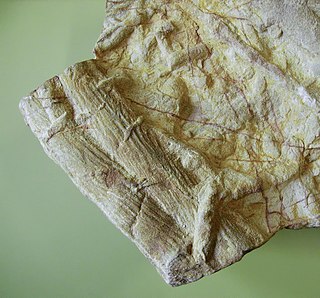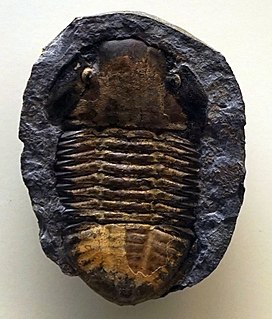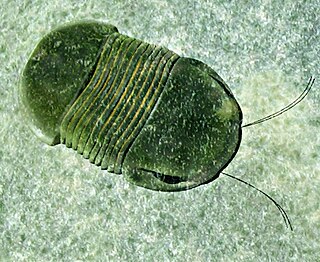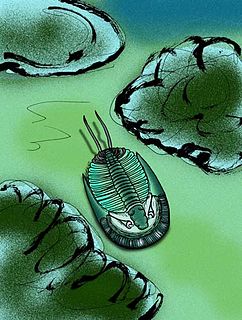The Ordovician is a geologic period and system, the second of six periods of the Paleozoic Era. The Ordovician spans 41.6 million years from the end of the Cambrian Period 485.4 million years ago (Mya) to the start of the Silurian Period 443.8 Mya.

Trilobites are a group of extinct marine arthropods that form the class Trilobita. Trilobites form one of the earliest-known groups of arthropods. The first appearance of trilobites in the fossil record defines the base of the Atdabanian stage of the Early Cambrian period, and they flourished throughout the lower Paleozoic before slipping into a long decline, when, during the Devonian, all trilobite orders except the Proetida died out. The last extant trilobites finally disappeared in the mass extinction at the end of the Permian about 252 million years ago. Trilobites were among the most successful of all early animals, existing in oceans for almost 270 million years, with over 20,000 species having been described.

Flexicalymene Shirley, 1936, is a genus of trilobites belonging to the order Phacopida, suborder Calymenina and Family Calymenidae. Flexicalymene specimens can be mistaken for Calymene, Gravicalymene, Diacalymene and a few other Calymenina genera. They are used as an index fossil in the Ordovician. Ohio and North America are particularly known for being rich with Flexicalymene fossils.

Gravicalymene Shirley, 1936, is a genus of trilobites belonging to the order Phacopida, suborder Calymenina and family Calymenidae. Species included in this genus have previously been allocated to Calymene Brongniart 1822,Flexicalymene Shirley, 1936. and Sthenarocalymene Siveter 1977.

Cruziana is a trace fossil consisting of elongate, bilobed, approximately bilaterally symmetrical burrows, usually preserved along bedding planes, with a sculpture of repeated striations that are mostly oblique to the long dimension. It is found in marine and freshwater sediments. It first appears in upper Fortunian rocks of northern Iran and northern Norway. Cruziana has been extensively studied because it has uses in biostratigraphy, and because the traces can reveal many aspects of their makers' behavior.

Hoekaspis is an extinct genus of trilobites from the family Asaphidae. It lived during the early part of the Arenig stage of the Ordovician, a faunal stage which lasted from approximately 466 to 461 million years ago.

Pytine is an extinct genus of asaphid trilobites. Species lived during the later part of the Arenig stage of the Ordovician Period, approximately 478 to 471 million years ago. Various species are found in the Svalbard, Valhallfonna Formation, Olenidsletta, Member, of Spitzbergen, Norway, the Megistaspis (Paramegistaspis) planilimbata Zone of the 'Shumardia Shale' of Sweden, Jujuy Province, Argentina, early Arenig-aged strata of Jiangxi province, China, and Darriwilian-aged strata in Western Hunan province, China. The type species, P. graia, has seven thorax segments, and lacks the rapier-like glabellar spine, that occurs in many other raphiophorids. The Chinese species, by contrast, have only six thoracic segments. So far, only the type species, and one of the Chinese species, P. laevigata, are known from complete specimens.

Lonchodomas is a genus of trilobites, that lived during the Ordovician. It was eyeless, like all raphiophorids, and had a long straight sword-like frontal spine, that gradually transforms into the relatively long glabella. Both the glabellar spine and the backward directed genal spines are subquadrate in section. Lonchodomas has five thorax segments and the pleural area of the pygidium has two narrow furrows. Lonchodomas occurred in what are today Argentina, Canada (Newfoundland), Estonia, Latvia, Norway, Sweden, the Russian Federation and the United States.

Bumastus is an extinct genus of corynexochid trilobites which existed from the Early Ordovician period to the Late Silurian period. They were relatively large trilobites, reaching a length of 6 in (15 cm). They were distinctive for their highly globular, smooth-surfaced exoskeleton. They possessed well-developed, large compound eyes and were believed to have dwelled in shallow-water sediments in life.

Angelina Salter, 1859, is a genus of ptychopariid trilobite belonging to the Family Olenidae, Suborder olenina. It lived during the Tremadocian Stage, lowermost of the two standard worldwide divisions forming the Lower Ordovician Series and lowest of the seven stages within the Ordovician System. It encompasses all rocks formed during Tremadocian times, which spanned the interval between 485.4 million and 477.7 million years ago. Fossilized remains of Angelina are known from Wales, Central and South America. It differs from most other Triarthrinae in being larger, with a relatively narrow glabella, the occipital ring poorly defined, and lateral glabellar furrows relatively obscure. Eyes are placed midlength that of the cephalon and the facial sutures converge on the front border at the midline. Species also have long genal spines.

The Folkeslunda Limestone is a thin limestone and mudstone geologic formation of Sweden. The formation crops out on the island of Öland to the east of Kalmar, where Folkeslunda is located. Other exposures of the formation are in Dalarna, Jämtland and Östergötland. The Folkeslunda Limestone was deposited in an open marine environment with an estimated water depth of 150 to 200 metres in a eustatically transgressive phase.
This list of fossil arthropods described in 2009 is a list of new taxa of trilobites, fossil insects, crustaceans, arachnids and other fossil arthropods that have been described during the year 2009, as well as other significant discoveries and events related to arthropod paleontology that occurred.

Entomaspis is an extinct genus of harpetid trilobite from Upper Cambrian to Early Ordovician marine strata of the United States. Species are typified by their proportionally large, vaulted, croissant-shaped or bonnet-shaped cephalons that have the cheeks freed to become elongated, curved librigenial spines, and by their comparatively large, crescent-shaped eyes.
Utahconus is an extinct genus of conodonts.

The Tucumilla Formation is a Tremadocian geologic formation of southern Bolivia. The sandstones, shales and siltstones crop out in the José María Avilés and Eustaquio Méndez Provinces.

The Iscayachi Formation, in older literature also referred to as Guanacuno Formation, is an extensive Tremadocian geologic formation of western and southern Bolivia. The shales and sandstones were deposited in a shallow marine to pro-delta environment. The formation reaches a thickness of 1,000 metres (3,300 ft).

The Obispo Formation is a Dapingian geologic formation of southern Bolivia. The shales and siltstones were deposited in an open marine environment.

The Sella Formation is a Dapingian to Darriwilian geologic formation of southern Bolivia. The grey to green bioturbated siltstones interbedded with thin sandstone layers bear lenticular shell beds. Other parts of the formation contain yellow-green limy shales and grey sandy limestones. Coquinas often fill gutter casts and included brachiopods, trilobites, bivalves and nautiloids. The sediments were deposited in an open marine environment. The species Coxiconchia sellaensis was named after the formation.

The Letná Formation is a Late Ordovician geologic formation of the Prague Basin, Bohemian Massif in the Czech Republic. The formation crops out in the Czech capital, more specifically at Letná Hill, after which the formation is named. The type locality is located at Malá Strana, Holešovice district.











